Back to Don's Maps
 Back to Archaeological Sites
Back to Archaeological Sites  Back to the review of hominins
Back to the review of hominins
Neanderthal Symbolism
Click on the photos to see an enlarged version
This is my translation of an excellent article (in French) by Marie Soressi and Francesco D’Errico at:www.researchgate.net/publication/40853224_Pigments_gravures_parures_les_comportements_symboliques_controverss_de_Nandertaliens
Which comes from Les Néandertaliens. Biologie et cultures. Paris, Éditions du CTHS, 2007 (Documents préhistoriques ; 23), p. 297-309
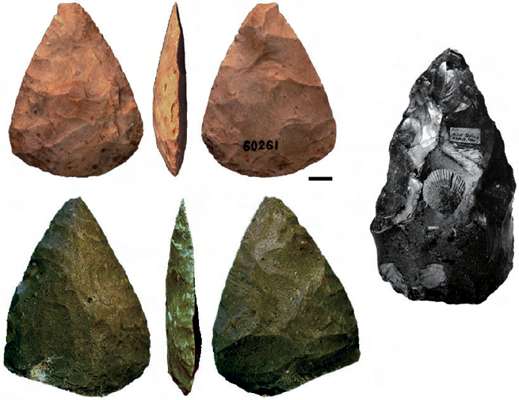
Neanderthal Tools
A biface Acheulean tool containing a fossil (right) from West Tofts, England, according to Bahn, 2000, unknown scale.
The other tools are Mousterean (Usually Neanderthal) bifaced Acheulean, carefully shaped on non-local raw materials.
(Pech de l’Azé I, niveau 4, Soressi, 2002; Chez Pinaud, US07, photo E. Claud), Scale (using the black bar) 1 cm
From Wikipedia: Acheulean is the name given to an archaeological industry of stone tool manufacture associated with prehistoric hominins during the Lower Palaeolithic era across Africa and much of Asia and Europe. It was the dominant technology for the vast majority of human history and more than one million years ago it was Acheulean tool users who left Africa to first successfully colonize Eurasia. Their distinctive oval and pear-shaped handaxes have been found over a wide area and some examples attained a very high level of sophistication suggesting that the roots of human art, economy and social organisation arose as a result of their development. Although it developed in Africa, the industry is named after the type site of Saint Acheul, now a suburb of Amiens in northern France, where some of the first examples were identified in the nineteenth century.
Pigments, engravings, jewellery
The controversial symbolic behaviour of the Neandertals
By Marie Soressi and Francesco D’Errico
A significant difference between the middle Palaeolithic and the upper Palaeolithic is the scarcity of evidence of the arts. There are few or no paintings, etchings or sculptures, and few if any decorations during the course of the middle Palaeolithic. The art of the Neanderthals is very equivocal in nature, as underlined by J. Jaubert in a recent summary of the behaviour of Neanderthals (Jaubert, 1999, p. 129). The relevant material is not only scattered and diverse compared to that seen in the upper Palaeolithic, but its interpretation is more difficult.
The implementation, in recent years, of a new analytical approach, allows the replacement of intuitive interpretations, which were often the norm in the past. The creation of experimental ethnographic or palaeontological benchmarks can define explicit analysis criteria that facilitate the interpretation of archaeological objects. The analysis is carried out at different scales, both macroscopic and microscopic, through the complete range of the archaeological material without prior selection of the most "beautiful" pieces. The aim is to reconstruct the process of acquiring the raw materials, the production of the objects, their use and their abandonment, with the aim of understanding the motivations behind the project and to assess their possible symbolic meaning.
The application of this new approach to objects interpreted in the past as evidence that Neanderthals had a symbolic material culture has revealed that several of the engraved or pierced bones have proven to be altered only as the result of natural processes. Other bones and some stone objects, in contrast, carry a series of regular incisions which appear of anthropic origin. In many cases, it is difficult to decide without a thorough analysis. Objects interpreted as curiosities collected by Neanderthals for non-utilitarian purposes are also subject to interpretation and remain controversial.
However, it now appears clear that there is a true Mousterian pigment technology, and that their use in symbolic activities is highly probable. Finally, the ornaments and decorations applied to bone objects by the Neanderthal cultures are not in doubt, and prove that some Neanderthal populations developed material cultures which were complex, and completely or almost completely comparable to those of the upper Palaeolithic.
Engraving - freeform, flowing decorations and sets of regular incisions
( Note that the engravings shown below have been shown to be only the imprint of vascular furrows or paths (paths made by arteries or veins on the surface of the bone, natural occurrences) (D'Errico and Villa, 1997 and 1998). This study has cast doubt on several other objects presenting similar freeform decorations, such as those of Cueva Morin (Echegaray Gonzalez and Freeman, 1971) and Stranska Skala (Valoch, 1987), for example. In the latter deposit one elephant vertebra was found with a series of seven furrows in a fan and two broader paths crossing the bone from top to bottom - Don )
One can distinguish freeform decorations from those bearing a series of regular, more or less parallel incisions. The objects with freeform, flowing decorations are all in bone, whereas objects carrying regular incisions are in both bone and stone.
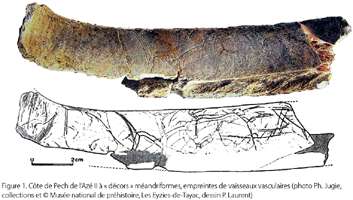
Figure 1
Rib from Pech Azé II with "macaroni decorations", with the marks of vascular vessels (photo Ph. Jugie,
© collections and Musée national de préhistoire, Les Eyzies-de-Tayac, drawing P. Laurent)
The most famous bone with flowing decorations is this rib fragment discovered by F. Bordes in Pech de l’Azé II, in an acheulean level (Fig. 1, left). The many serpentine tangled lines present on one side of the rib fragment were interpreted by the discoverer and other authors (Donald, 1991) as a deliberate engraving. This interpretation was confirmed by microscopic analysis carried out by Marshack, who saw in this engraved motif the precursor of the "macaroni" art (macaroni/meander art is a form of randomly meandering finger flutings) visible on the walls of many decorated caves of the upper Palaeolithic.
(Pech de l’Azé is a cluster of four Lower and Middle Paleolithic sites. They are situated some 50 metres higher than the floor of a small, usually dry, valley that runs into the Enéa, a small tributary of the Dordogne River. Pech de l’Azé I and II are opposite entrances of a single tunnel-like cave that intersects a promontory in the limestone cliff. - http://www.oldstoneage.com/pechiv/pechsites.htm)

This is a photograph of the rib fragment, showing the macaroni engravings, rotated 180° to conform with the image above.
Photo: Don Hitchcock 2014
Source: Original, display at Musée National de Préhistoire, Les Eyzies
In fact, the microscopic analysis of this subject in light microscopy and Scanning Electron Microscopy and its comparison with existing bones has shown that:
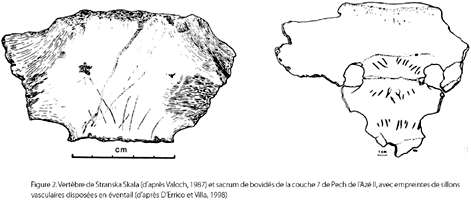
Figure 2
Vertebra of Stranska Skala (after Valoch, 1987) and a bovine sacrum in layer 7 of Pech de l’Azé II, with vascular furrows arranged in a fan (after D'Errico and Villa, 1998)
However on the sacrums (the sacrum is a triangular bone made up of five fused vertebrae and forming the posterior section of the pelvis) of current and archaeological Bovidae (cattle, sheep, goats) there have been observed vascular furrows or paths in a fan shape similar to that seen on the vertebrae of Stranska Skala (D'Errico and Villa, 1998; Fig. 2, left). The microscopic analysis and comparison of archaeological objects with non archaeological objects are essential to diagnose whether these arise from natural or human actions. It has become a preliminary step for the proposal of interpretative theories on these first art forms.
A series of regular incisions were described on objects in bone or stone from more than a dozen sites of Lower and Middle Paleolithic Europe. Unlike previous freeform paths, the series of cuts are deep and regular morphology; they are organised, regularly spaced, most often oblique with respect to the axis of the piece. The recent review of all the objects found on the Molodova site in Ukraine, shows that the engravings and incisions are probably not of anthropic origin (D'Errico et Al, 2003).

Figure 3
Bone from Bilzingsleben (Germany) displaying groups of parallel striations (after Mania and Mania, 2004)
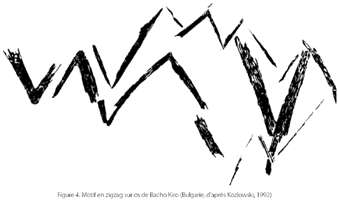
Figure 4
Zig zag motif on a bone from Bacho Kiro, Bulgaria (after Kozlowski, 1992)
However, the engravings of Bilzingsleben (Fig. 3, above), dated from the Lower Paleolithic, or those found in the middle Paleolithic context of Puycelsi, Petit Puymoyen, La Quina, and Bacho Kiro (Fig. 4, left), remain enigmatic. The morphology of the features and their distribution, in the light of recent studies, indicate that most of the cuts on these pieces may well be due to man. Nevertheless, microscopic analysis should be conducted to make sure. In cases where this anthropic origin is confirmed, it would be as well to ascertain whether one or more flint tools were used to trace these lines.
That would make it possible to understand if these features were carried out during just one session or during several sessions, probably separated in time. The development of an experimental reference frame would make it possible to determine which traces left on the bone were from its use as a cutting board in activities such as the cutting up of organic material (such as meat or vegetable matter), and to compare these traces with those observed on archaeological objects.
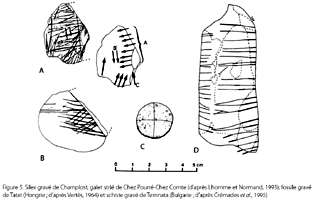
Figure 5
Engravings were also recognised on stone artefacts. Sometimes they are straight lines, but more often they are circular, more or less entangled (Fig. 5). (All the engravings in Figure 5 appear to be straight lines) The anthropic origin of the engravings found on stones or flint cores at Champlost, at Pourré-At Count (Lhomme and Normand, 1993) and Temnata (Crémades et al, 1995) has been demonstrated, but their significance remains enigmatic.
Perforations - jewellery and "musical instruments" created by natural causes
Several pieces of bone with perforations were interpreted as ornaments (Pech de l'Azé II, Roche Bois, in France, Kulna in the Czech Republic), as whistles (La Quina, Combe Grenal in France, Bocksteinschmiede in Germany, Prolom II in the Crimea), or where there were multiple perforations, as flutes (Divje Babe in Slovenia). Recent work has shown that these holes are not due to man - and that therefore these objects can not be used to support the symbolic systems of Neanderthal cultures. The perforations on the objects from Roche Bois, Pech of Azé II and Kulna (Bordes, 1969; Vincent, 1987 and 1993) resulted from the attack by gastric juices on these bones (D'Errico and Villa, 1997 and 1998).Studies of hyena dens, current and fossil, show that the gastric juices of these large carnivores corrode and pit bone, almost piercing it. The edges of the ends of bone pieces become thin and sharp. The perforations produced by this process are cylindrical, unlike perforations by rotation with a flint tool, which are conical or biconical and leave characteristic traces, absent on the objects from Bois Roche, Pech II and Kulna.
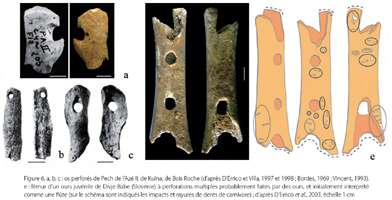
Figure 6
a, b, c: perforated bones from Pech de l’Azé II, Kulna, and Bois Roche (after D’Errico et Villa, 1997 and 1998; Border, 1969; Vincent, 1993). e: femur of a juvenile bear from Divje Babe (Slovenia) with multiple perforations probably made by bears, and initially interpreted as a flute (on the diagram the impacts and scratches of teeth of a carnivore are indicated); after D'Errico et al., 2003, scale (using the black bar) 1 cm.
In the same way, the perforations on phalanges (toe bones) of reindeer from Quina, interpreted as whistles (Henri-Martin, 1907 and 1909), seem to be the result of the combined effect of chewing and digestion by carnivores, and even of post-depositional deterioration (Chase, 1990; Taborin, 1990; D'Errico and Villa, 1998). Lastly, microscopic analysis and the study of frames of reference of bear dens made it possible to show that the flute of Divje Babe in Slovenia (Turk, 1997; fig. 6) was a femur of a young cavebear probably pierced by the bears themselves (Chase and Nowell, 1998; D'Errico et al, 2003; D'Errico and Lawson 2006). The perforations on this object are very similar (in morphology, dimension, locality on the bone) to those which one meets in accumulations of cavebear bones where there is no trace of human presence.
Not only that, there is no trace of any human marks on the "flute", but plenty of evidence of a carnivore. Some impressions of teeth can be found on the back of the flute which correspond to a bite from a carnivore which was also responsible for the perforations. These objects cannot be used to support the idea of Neanderthals making and wearing jewellery or making musical instruments. These recent analyses also reveal that it is very dangerous to take the object out of its context.
For most of these sites, objects interpreted as jewellery or musical instruments were selected from a set of objects which resembled them, but seemed to be intuitively less obviously man-made. At Bois Roche for example, more than 400 bones carry simple or multiple perforations, sometimes full, sometimes complete, sometimes incomplete (D'Errico and Villa, 1998). In addition, Bois Roche is a den of hyenas and humans are not the progenitors of the bone accumulation (Villa and Bartram, 1996; Villa and Soressi, 2000). Assuming that the objects were worn as pendants by the Neanderthals, of which we have no proof, why would they then be abandoned in a den of hyenas? There is evidence that these objects were not made by humans and, given the context of their discovery, it is simpler to think that they have never been used by humans.
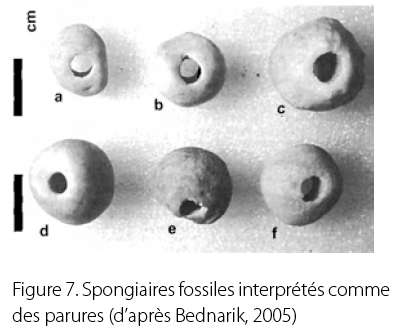
Figure 7
Fossil sponges interpreted as jewellery (after Bednarik, 2005)
Fossils of spherical shape belonging to the sponge species Porosphera globularis and showing natural perforations were reported in acheulean sites in northern France and England. According to Kelley, Marshack and, more recently, Bednarik (Bednarik, 2005; fig. 7) certain pieces could carry traces of an intentional modification or wear due to their use as ornamental objects. A morphometric study coupled with a microscopic analysis of the archaeological pieces is underway by S. Rigaud, F. D’Errico and M. Vanhaeren to verify the hypothesis of a symbolic use. The demonstration of collection and symbolic use of these fossils by the Neanderthals would be important, as the first beads to date are drilled marine shells discovered in the sites of the Near East, North Africa and Southern Africa, inhabited by anatomically modern humans (Vanhaeren et al., 2006).
Stone tools which were made too well
Of thousands of Mousterian Acheulean tools, some rare specimens were carried out on blanks of remarkable origin, or on a blank containing a fossil, the shaping preserving the fossil intentionally. Most of the pieces have been shaped by a knapper of great knowledge, admirably and with great care. Some commentators see this as evidence of a desire to sign these tools, especially for some two-sided specimens (Mithen 1996). However, in the case of the biface acheulean hand axe from West Tofts, for example, there is no clear evidence of the intent to conduct shaping around the fossil, judging from the photo published (Bahn, 2000; fig. 8). The fossil was probably already at the center of the block of raw material before processing, finished off with just a small amount of material removed.

Figure 8
A biface Acheulean tool containing a fossil (right) from West Tofts, England, according to Bahn, 2000, unknown scale.
The other tools are Mousterean (Usually Neanderthal) bifaced Acheulean, carefully shaped on non-local raw materials.
(Pech de l’Azé I, niveau 4, Soressi, 2002; Chez Pinaud, US07, photo E. Claud), Scale (using the black bar) 1 cm
Furthermore, in cases where there was a high degree of investment of technical skill, such an investment may simply be a consequence of minimizing risk-taking. On a beautiful blank of good material, a tool of good quality is cut by a highly qualified flint knapper, not a novice. Then, once the object has been successfully made, it is selected to be used and transported from its place of origin because the precision and good design allow it to be resharpened many times. The investment technique helps to minimize risks, in an economic system where activities are planned in the long term. It is a quite logical behaviour, in the context of the traditional Mousterian acheulean for example (Fig. 8), where the more well made objects are used away from the place of origin, after transport and after knapping. These pieces are not any different from other pieces with which they are found in terms of the methods employed or in size, only the selection of the block and the know-how invested in the piece are more important. It is thus not necessary to call upon the function of a signature to explain their production and the organisation of their use in the area.
The collection of curiosities (fossils, minerals)
Prehistorians have traditionally put under the title "curiosities" those unmodified objects, made up of exotic or rare raw materials, for which it is difficult to propose a functional use. According to M. Otte, "their choice and their transport express the trouble which they have perhaps caused and are perhaps at the root of the symbolic meaning given to them, as is the case with respect to similar objects in primitive societies of today (i.e. talismans, fetishes, chirungas)" (Otte, 1996, p. 177).With respect to crystals, fossils, and other minerals, their discovery in a Neanderthal site, far from their natural place of deposition, evokes, but does not demonstrate, the use of symbolism, nor that this use had left discrete traces, detectable only under the microscope. After all, none of these objects was analysed thoroughly by using adequate reference frames to seek possible traces of use, nor of links which could testify to the symbolic function of these objects.

Figure 9
Globular coral and spiral gastropod fossil found in the Mousterian
of the Grotte de l’Hyène (Cave of the Hyena) at Arcy-sur-Cure (after Poplin, in Otte,
1996) and a brachiopod of the family Terebratulid from Bajocien, transported more than 30 km (after Soressi, 2002), scale (using the bar) 1 cm.
At Arcy-sur-Cure, two fossils were found in the final Mousterian of the Grotte de l’Hyène: a globular coral a few centimetres in diameter and a spiral gastropod (Fig. 9). At Pech de l’Azé I, in the lower level (level 4), one of us (M. Soressi) has recognized a brachiopod of the family Terebratulid, the lamp shells, transported more than 30 km, which for this deposit attests to long distance transportation: less than 0.5% of the raw material for stone tools has been transported over such a long distance (Soressi, 2002). Several transported fossils were recognized in Combe Grenal, or Chez Pourré-Chez Comte, for example, with the latter one coming from several tens of kilometres away (Lhomme and Freneix, 1993). These curiosities often testify to single events in an archaeological unit. It is only when this behavior is repeated from one layer or site to another that it confers a less anecdotal stature to the event which is challenging.
The Use of Pigments
Blocks of pigments have long been classified as curiosities. However, some commentators have for a long time argued for their use as colorants. The technological and microwear analysis of this material, carried out in parallel with the creation of an experimental reference frame, makes it possible to interpret the use of the dyes by Neanderthals on a new basis. This work is in hand, but already we can show the transport of these pigments between sites and we can describe how to use them. In Europe, more than 70 levels dated Lower and Middle Paleolithic delivered blocks of pigments or objects that were used to crush the pigment. Most often, they are the black pigment manganese dioxide, more rarely they are ochre. Most of these deposits date from the end of the middle Paleolithic, between 60 000 and 40 000 years ago, and were allotted to the Acheulean Mousterian tradition or the Charentien Mousterian. We have begun to combine in the study of this category of remains using both microscopic analysis and a rugosimetric study (rugosimetry measures surface roughness).

Figure 10
Microscope infinite focus and 3D reconstruction of the surface of pigments. The experimental reference frame consists of friction on sandstone and then tracing marks onto the skin.
This is possible, without danger to the objects, thanks to special equipment that involves no contact with the surfaces, but provides a 3D reconstruction of the microtopography surface, and high resolution images (Fig. 10) (as well as false colour images). This equipment also allows quantification of the surface by measuring roughness variables. You can compare on the same basis microwear on archaeological objects and those produced experimentally while simultaneously freeing oneself from the qualitative character of simple subjective microscopic observations. Microwear on Neanderthal pigments colorants inspired an experimental protocol leading to the classification of thirteen different types of modification and use, which include the production of powder by scraping with a sharp flint tool, abrasion on different types of stone, coloring hides, or their use in body paintings (Fig. 10). Our analyses have so far concentrated on two sources close to each other: Pech de l’Azé I and Pech de l’Azé IV. Excavated in the 1960s by François Bordes, the first site has delivered the largest collection of Mousterian pigments known at this time (Soressi et al., 2002).
(The distinguished archaeologist James R. Sackett has written an interesting short Biography of François Bordes which may be of interest to readers - Don )
This deposit has also delivered one of the few well preserved skulls of young Neanderthal children. More than 500 blocks of pigment were discovered, some found during our recent excavations at a level of more than 43 000 years BP (Soressi et al., 2007). The deposit has been excavated from the nineteenth century, so it is likely that the 500 blocks and fragments being studied are in fact less than half of all colorants abandoned on the deposit by the Neanderthals. Pech IV is within 80 metres of Pech I, and its upper layers are contemporary with this latter deposit (McPherron et al., 2001; McPherron and Dibble, 2000), but, unlike Pech I, only a very small number of dyes was found Pech IV: 26 pieces, spread over 9 archaeological levels, of which 15 were obviously used.
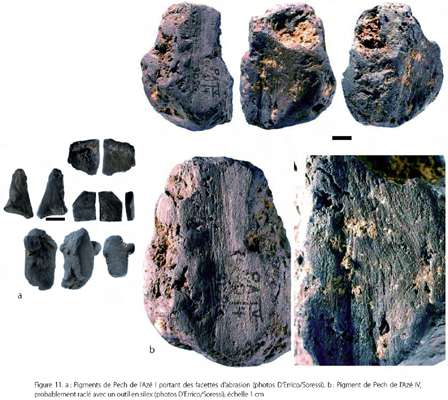
Figure 11
a: Pigments from Pech de l’Azé I carrying abrasion facets (photos D’Errico/Soressi).
b: Pigment from Pech de l’Azé IV, probably scraped with a flint tool (photos D’Errico/Soressi), scale (using the bar) 1 cm.
These pigments are mostly pieces of manganese dioxide used to make a black colour. A few pieces of red and yellow ochre were also found, but none of them bears clear traces of use. One finds these pieces of pigment in a natural state in the environment close to the sites, so the supply is local. Observation of the manganese dioxide blocks shows that there is a clear difference between the natural surface of the piece, which is irregular, and areas used by humans, which are levelled by abrasion and in some cases polished (fig. 11). Most of the blocks of manganese dioxide bear clear traces of use: at least 250 pieces were used at Pech I, a little more than twenty at Pech IV.
( Note that Heyes (2016) has shown that the Neanderthals at at Pech-de-l'Azé I were deliberately collecting manganese dioxide for a different purpose. Statistically designed combustion experiments and thermo-gravimetric (TGA) measurements demonstrate that manganese dioxide reduces wood's auto-ignition temperature and substantially increases the rate of char combustion; in other words, manganese dioxide facilitates the making of fire - Don )
Several facts indicate that these abrasions and polishing are intentional and due to the use of pigments and not natural or post depositional alterations.
- these blocks of pigments are associated with the objects having been used to work them such as a grinding stone or a flint tool)
- the worn faces on these blocks are similar to those observed in pigments from the Upper Paleolithic, and are the same as those we have produced experimentally.
- the position and morphology of wear surfaces on the blocks are not random and are not likely to have been created by natural phenomena.
Very few of these pieces of pigment appear to have been scraped or engraved by a sharp object like a flint edge or a piece of bone (Fig. 11). Most were abraded, which produced faces covered with fine parallel scratches. 70% of the facets carry scratches visible with the naked eye. The others carry microscopic scratches or have completely polished surfaces. The location of facets on the piece and the direction of the scratches indicates that the movement during abrasion followed a set pattern.
The narrow edges of the blocks were systematically used in order to produce elongated faces. To produce these facets, the Neanderthal exerted a back and forth movement on a flattened grinding stone, in a direction parallel or oblique with the axis of the future facet. This process has helped to produce many facets which are flat or slightly convex. In addition, some pieces bear traces of wear on the pointed ends and at the intersection of facets, indicating that they were used like pencils.
We noted that several uses seemed not to correspond to the depth, the density and the morphology of the scratches observed on the archaeological pigments. For example, scratches corresponding to friction on a fine sandstone similar to that found on the site are quite specific and are found only on a very small proportion of the archaeological finds. At the other extreme, the polish obtained in experiments by the friction of a block of pigment on wet skin is very different from the polishes observed in the archaeological piece. At this stage, our analysis in progress shows that among the blocks of Pech de l’Azé I, more than half were abraded on sandstone before being used on flexible surfaces, such as dry animal hide or human skin. .
The abrasion of the pigments on pieces of sandstone, also found during excavations, seems to have been carried out by Neanderthals with the aim of creating elongated facets with a strong colouring capacity, which could be used to mark, as one would with a charcoal pencil, various flexible materials, including the human skin, to carry out body painting. The methods of use of the blocks of Pech IV do not seem very different. Certain pieces however carry grooves produced by scraping the surface with a flint flake or retouched tools. That indicates that in parallel with the use of charcoal, Neanderthals produced manganese dioxide colouring powder to be used as such or, more likely, mixed with a bonding agent. By considering the volume of sediments excavated at the two sites, the inhabitants of Pech IV used fewer pigments than those of Pech I, and in the latter site used far more pigments in the lower layers than in the upper layers.
The blocks of pigments are thus used intensely under certain circumstances or at certain times, but seldom in others. It is the determination of these circumstances which should bring to us additional keys for the comprehension of the significance of the use of the pigments by the Neanderthals. Already we know that this change of behaviour is certainly not related to a disappearance of the manganese dioxide in the environment because, on the one hand, much manganese dioxide was used in the area in the upper Palaeolithic, and moreover, accessibility to the manganese dioxide deposits was probably unchanged between the lower levels and the higher levels of Pech I: the environment seems to have remained the same one, as measured by the composition of the faunal spectrum.
Thanks to technological and microwear analysis, these pigments have changed from the status of curiosities to the status of objects actually used. In traditional societies studied by ethnography, the pigments are used for symbolic activities, but also with a functional aim (protection from the sun, tanning of skins, preserving, medication). An exclusively functional use has not been demonstrated and would even be difficult to prove given the ubiquitous nature of symbols in human societies. If the current model (of hunter gatherer societies) is applied to Neanderthal societies, routine use of pigments by these societies is a strong argument in favour of their ability to develop symbolic cultural practices.
Chatelperronian ornaments and decorations
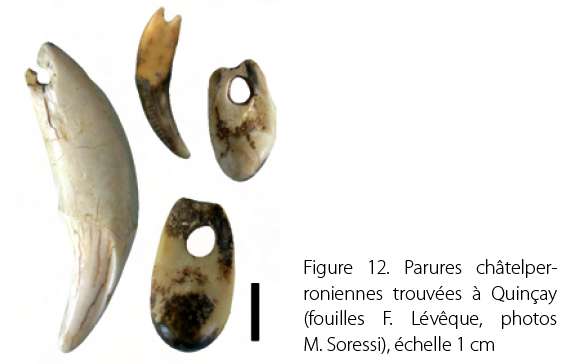
Figure 12
Chatelperronian ornaments found at Quinçay (excavations F. Lévêque, photos M. Soressi), scale (using the bar) 1 cm.
Nearly forty elements of jewelry were found in Chatelperronian levels of the Grotte du Renne at Arcy-sur-Cure. The last Chatelperronian levels of Quinçay (Granger and Lévêque, 1997) have also given us six pierced animal teeth (Fig. 12).
Several bored shells were also found in Uluzzian deposits in Italy and Greece.
(In Italy the lithic industries found immediately after the Mousterian are classified as belonging either to the Uluzzian or to the Aurignacian, and there seems to be a tacit assumption that the former were made by Neanderthals while the latter were made by modern humans, Homo sapiens.
- http://www.ucl.ac.uk/prehistoric/reviews/04_04_mussi.htm)
The human remains associated with the Chatelperronian ssites seem to indicate that Neanderthals are the originators of the Chatelperronian. Some of the Chatelperronian bone tools from the cave of the Grotte du Renne (Reindeer Cave) at Arcy-sur-Cure were decorated (D'Errico et al., 2001). Several facts show that these objects were indeed manufactured by Neanderthals, and are not the result of contamination or exchanges of objects with the first Aurignaciens. For the bone industry for example, the finished products are associated the bone chips. They are found in greater numbers in the oldest Chatelperronian levels, in zones of the site different from those where the Aurignacian industry was found and well within the structures identified during the excavation of these layers by Leroi-Gourhan (D'Errico et al., 2001).
Similar results were observed for the characteristic Chatelperronian ornaments and the association between the ornaments, bone industry, human remains and the flint tools characteristic of the Chatelperronian (Hublin and Soressi, 2006 and in preparation). Lastly, the technique of perforation is different: The Chatelperronian favoured in Quinçay a perforation by pressure or percussion after thinning of the part by abrasion, whereas Aurignaciens proceeded by scraping, even grooving, continuously until the hole was complete (Granger and Lévêque, 1997). The intensive use of pigments is also documented with Arcy-on-Cure: the ochre layers are sometimes several centimetres thick. More than 20 kg of pigments were also found in one of the Chatelperronian levels of the Grotte du Renne; granite mortars used with ochre were also reported. According to Leroi-Gourhan, a part of this ochre was heated before use (Baffier, 1999, p. 82).
Discussion
In recent years, the application of increasingly sophisticated analytical methods and the adoption of an approach based on the comparison between archaeological and adapted tailored benchmarks have shown that many objects interpreted in the past as ornaments or decorated objects are actually of natural origin.
It is now essential to analyse objects in their context and not to select in a group the pieces that would be more easily categorised: the study of the group and the context of their deposition is as diagnostic as the study of the piece itself.
A rigorous analysis of potentially symbolic objects must be based on a study at several scales: the scale of the assemblage and of its context, as well as on both the macroscopic and microscopic scale. Each of the scales of analysis is inseparable and its interpretation must be based on similarities of origin and known function, as distinct from what has been analysed.
The facts to support the existence of artistic activities among the oldest Neanderthals are rare. However, from 60000 years ago, the use of colours, and the manufacture of jewelry and ornamentation of bone objects using abstract decoration have made archaeological evidence easier to interpret.
Some of these activities, such as the use of pigments, appear to have developed well before any direct contact with modern humans. With regard to the ornamentation and decoration of bone objects, the scientific community is divided.
Some see these events as autonomous developments, some as the result of contact between Neanderthals and modern, others as an acculturation of Neanderthals, which had not given much to modern man given the cognitive superiority of the latter.
Finally, some authors believe that Neandertals had not really been influenced by modern men but would rather have blindly copied their behaviour without understanding the implications of it. That is becoming an increasingly minority viewpoint, and a consensus appears to be emerging that even in cases where some of these activities would have been acquired by contact, it was made possible because the neanderthal societies possessed an understanding of social systems and techniques which permitted this exchange.
It is dangerous to infer from the lateness of this development that Neandertals were limited in their cognitive abilities so far as artistic activities are concerned.
Indeed, it is only the more modern Europeans, from later times than the last Neanderthals, whose artefacts show evidence of prolific artistic activity.
The situation is different elsewhere in the world, before or even after 35000 years. Finally, it is clear that much work remains to be done. Most of the objects under consideration, such as "curiosities" (curiosities are objects such as pieces of fossil coral or shells which serve no obvious utilitarian purpose, but have been carried some distance from their place of origin), as well as most pieces carrying regular incisions, have not been analysed with modern methods. It is essential to have more data to clarify the context of the development of symbolism in the Neandertals. It is only then that the art becomes less ambiguous.

Bibliography as a graphic (304 Kb)
Bibliography as text (52 Kb)
References
- Heyes, P., et al., 2016: Selection and Use of Manganese Dioxide by Neanderthalst, Scientific Reports, | 6:22159 | DOI: 10.1038/srep22159, https://www.universiteitleiden.nl/en/news/2016/02/neanderthals-collected-manganese-dioxide-to-make-fire
- Soressi, M., d'Errico, F., 2007: Pigments, gravures, parures: les comportements symboliques controversés de Néandertaliens www.researchgate.net